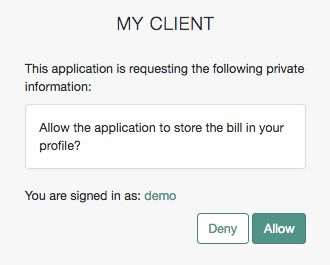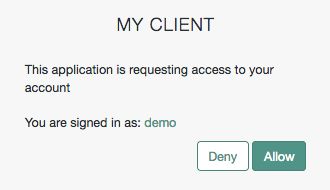About Scopes
OAuth 2.0 flows require scopes to limit the client's access to the resource owner's resources.
Scopes are a way to restrict client access to the resource owner's resources, as defined in the OAuth 2.0 Authorization Framework.
Scopes are not associated with data and, in practice, they are just concepts specified as strings that the resource server must interpret in order to provide the required access or resources to the client. The OAuth 2.0 framework does not define any particular value for scopes since they are dependent on the architecture of your environment.
For example, a client may request the write scope, which the resource server may interpret as that the client wants to save some new information in the user's account, such as images or documents.
A client can request one or more scopes, which AM may display in the consent screen. If the resource owner agrees to share access to their resources, scopes are included in the access token.
For security reasons, AM only accepts scopes preconfigured in the Scope(s) or in the Default Scope(s) fields in the client profile (Realms > Realm Name > Applications > OAuth 2.0 > Clients > Client Name > Core).
AM checks the requested scopes against the Scope(s) field of the client's profile. If the client requests a scope that is not preconfigured, AM returns an error, such as Unknown/invalid scope(s).
If a client does not request any scopes, AM uses the scopes configured in the Default Scope(s) field of the client's profile. If none are configured, AM uses those configured in the Default Scope(s) field of the OAuth 2.0 provider.
If no scopes are configured by default, AM returns the No scope requested error. AM does not use the default scopes in any other circumstance.
Tip
The Client Registration Scope Whitelist field of the OAuth 2.0 provider restricts the scopes a client can register with. In that sense, it is used for OpenID Connect discovery and dynamic client registration only.
You can use this field, however, to configure how AM presents the scopes in the AM consent screen. By default, scopes are not configured to display in the consent screen. You can either disable the consent pages, or configure the scopes for display as described below.
Since scope names are arbitrary, in some cases they would not be descriptive enough for the resource owner to understand their purpose. In other cases, you may not want the resource owner to see a particular scope because it is for internal uses only.
You can configure the AM consent screen to show, for each scope, one of the following options:
Configure how scopes appear in the consent screen by client or by realm (in the OAuth 2.0 provider service). For examples, see the Client Registration Scope Whitelist field in the provider's "Advanced" reference section or the Scope(s) field in Core Properties.
Client level configuration overrides that at provider level.
AM reserves the following special scopes that cannot be added during dynamic client registration:
- am-introspect-all-tokens
Add this scope to the Scopes(s) field in a client profile to let the client introspect tokens issued to other clients, as long as all clients are registered in the same realm.
For example:
Client A is registered in the
/customers/NArealm, and it is issued a token there.Client B is registered in the
/customersrealm. It cannot introspect Client A's token because they are not in the same realm. Client B can only introspect tokens from other clients registered in the/customersrealm.
- am-introspect-all-tokens-any-realm
Add this scope to the Scopes(s) field in a client profile to let the client introspect tokens issued to other clients, as long as they are registered in the realm of the introspecting client, or in a subrealm of it.
For example:
Client A is registered in the
/customers/NArealm, and it is issued a token there.Client B is registered in the
/customersrealm. It can introspect Client A's token because the/customers/NArealm is a subrealm of the/customersrealm.Client B can introspect tokens for any client registered in the
/customerrealm, or any subrealm of it.
For security reasons, give these scopes only to the clients that need them.
Related information:
For examples of requesting scopes from the authorization server, see any of the grant flows in OAuth 2.0 Grant Flows.
To create your own implementation of the scope handler, see "Customizing OAuth 2.0 Scope Handling".
To configure AM to grant scopes dynamically by evaluating authorization policies at runtime, see About Authorization and Policy Decisions and Dynamic OAuth 2.0 Authorization.


